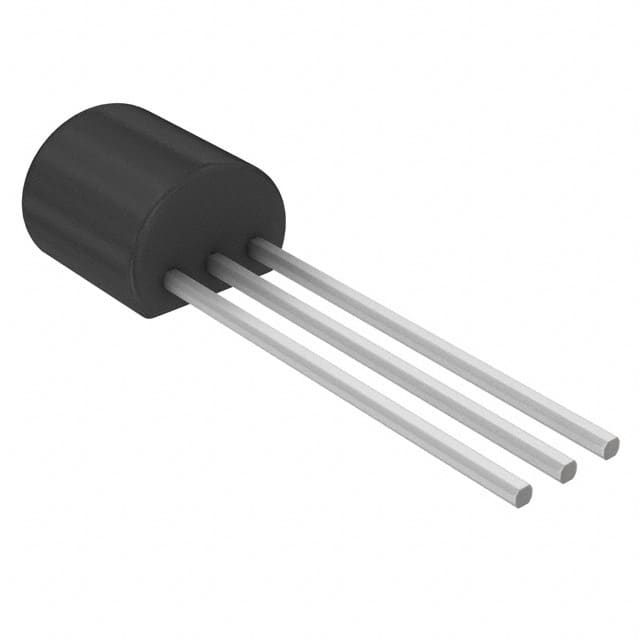Veja as especificações para detalhes do produto.

2N4400TA
Product Overview
The 2N4400TA is a general-purpose NPN bipolar junction transistor (BJT) commonly used in electronic circuits for amplification and switching applications. This transistor belongs to the category of discrete semiconductor components and is widely utilized in various electronic devices due to its versatile characteristics.
Basic Information Overview
- Category: Discrete Semiconductor Component
- Use: Amplification and Switching
- Characteristics: High current gain, low noise, and low power dissipation
- Package: TO-92
- Essence: NPN Bipolar Junction Transistor
- Packaging/Quantity: Typically available in reels or tubes containing multiple units
Specifications
- Collector-Base Voltage (VCBO): 60V
- Collector-Emitter Voltage (VCEO): 40V
- Emitter-Base Voltage (VEBO): 6V
- Collector Current (IC): 600mA
- Power Dissipation (PD): 625mW
- Transition Frequency (fT): 250MHz
- Operating Temperature Range: -55°C to 150°C
Detailed Pin Configuration
The 2N4400TA transistor has three pins: 1. Collector (C): Connected to the positive supply voltage in most circuit configurations. 2. Base (B): Used to control the flow of current between the collector and emitter. 3. Emitter (E): Connected to the ground or negative supply voltage in most circuit configurations.
Functional Features
- High current gain allows for efficient signal amplification.
- Low noise characteristics make it suitable for low-level signal amplification.
- Low power dissipation enables energy-efficient operation.
Advantages and Disadvantages
Advantages
- Versatile application in both amplification and switching circuits.
- High current gain provides effective signal amplification.
- Low noise characteristics make it suitable for audio applications.
Disadvantages
- Limited maximum collector current compared to other power transistors.
- Relatively lower power dissipation capability compared to high-power transistors.
Working Principles
The 2N4400TA operates based on the principles of bipolar junction transistors, where the flow of current between the collector and emitter is controlled by the base current. By modulating the base current, the transistor can amplify or switch electronic signals effectively.
Detailed Application Field Plans
The 2N4400TA finds extensive use in various electronic applications, including: - Audio Amplifiers - Signal Processing Circuits - Switching Circuits - Oscillator Circuits - Voltage Regulators
Detailed and Complete Alternative Models
Some alternative models to the 2N4400TA include: - 2N4401: Complementary PNP transistor with similar characteristics - BC547: General-purpose NPN transistor with comparable specifications - 2N2222: NPN transistor with higher current and power handling capabilities
In conclusion, the 2N4400TA is a versatile NPN bipolar junction transistor with wide-ranging applications in electronic circuits, offering high current gain, low noise, and efficient performance in amplification and switching tasks.
[Word Count: 411]
Liste 10 perguntas e respostas comuns relacionadas à aplicação de 2N4400TA em soluções técnicas
What is the 2N4400TA transistor used for?
- The 2N4400TA is a general-purpose NPN bipolar junction transistor commonly used for amplification and switching applications in electronic circuits.
What are the key specifications of the 2N4400TA transistor?
- The 2N4400TA has a maximum collector current (Ic) of 600mA, a maximum collector-base voltage (Vcb) of 60V, and a maximum emitter-base voltage (Veb) of 6V.
How can the 2N4400TA be used in amplifier circuits?
- The 2N4400TA can be used as a small-signal amplifier in audio and radio frequency (RF) circuits due to its low noise and high gain characteristics.
Can the 2N4400TA be used for switching applications?
- Yes, the 2N4400TA can be used to control the flow of current in electronic switches and relays, making it suitable for various switching applications.
What are the typical operating conditions for the 2N4400TA?
- The 2N4400TA is typically operated within a temperature range of -55°C to 150°C and is suitable for use in a wide range of environments.
Are there any common alternative transistors to the 2N4400TA?
- Yes, some common alternatives to the 2N4400TA include the 2N4401, BC547, and 2N2222 transistors, which have similar characteristics and can be used in its place in many circuits.
What are the recommended circuit configurations for the 2N4400TA?
- The 2N4400TA can be configured in common emitter, common base, or common collector configurations depending on the specific requirements of the circuit.
How do I determine the appropriate biasing for the 2N4400TA in my circuit?
- The biasing of the 2N4400TA can be determined based on the desired operating point, load requirements, and the specific application of the transistor in the circuit.
Can the 2N4400TA be used in high-frequency applications?
- While the 2N4400TA can be used in RF circuits, it may not be suitable for very high-frequency applications due to its transition frequency and capacitance characteristics.
Where can I find detailed datasheets and application notes for the 2N4400TA?
- Detailed datasheets and application notes for the 2N4400TA can be found on semiconductor manufacturer websites, distributor platforms, and electronics component databases.

